EERE Success Story—Geothermal Technology to Help Meet High Lithium Demand
November 30, 2016
The Salton Sea region is one of North America's prime sources of lithium. | Photo Courtesy: Pure Energy
In 2014, the Energy Department’s Geothermal Technologies Office introduced its mineral recovery research and development program to identify methods of recovering lithium and rare earth elements found in geothermal fluids. This year the effort expanded to include evaluation of comparable methods in other industries and the potential to translate successful methodologies for use in geothermal mineral recovery.
Lithium and rare earth elements typically maintain high commodity value and are used in a range of specialized industrial and technological applications. They furthermore represent a new revenue stream for geothermal operators – by validating methods for recovering and purifying critical materials, the economic and production benefits of geothermal energy projects can be improved, making them more cost-competitive at a wider range of locations.
The California Energy Commission (CEC) recently selected SRI International for extended research funding via the Energy Department’s Funding Opportunity Announcement: “Improving the Cost-Effectiveness and Operational Flexibility of Geothermal Energy Production.”
Over the next two years SRI will continue geothermal mineral recovery research – initiated two years ago via the Energy Department’s Geothermal Technologies Office – focusing on advances in lithium recovery from geothermal brines using ion-imprinted polymers. Lithium is among a class of elements that plays a vital role in many energy technologies, including solar, wind, electric vehicles and energy-efficient lighting.
SRI’s original efforts centered on extracting lithium and manganese from potential geothermal sources. Going forward, their research efforts will focus on lithium recovery from the geothermal fluids extracted in California’s Salton Sea region. Under the DOE award, tests showed that lithium separation via ion-imprinted polymers is highly effective – in one process, more than 90% of retrievable lithium was separated from a test brine.
Continued refinement of sorbent capacity and selectivity is, however, required to produce an effective production-caliber brine separation system, which is where the CEC’s research funding comes into play. To support this goal, SRI’s immediate technical objective is to further advance the performance and efficiency of ion-imprinted polymers to achieve optimal lithium separation rates exceeding 95%.
EERE accelerates development and deployment of energy efficiency and renewable energy technologies that strengthen U.S. energy security, environmental quality, and economic vitality. Visit the Geothermal Technologies Office to learn more about funding opportunities and efforts to develop innovative technologies capable of locating, accessing, and developing geothermal resources.

